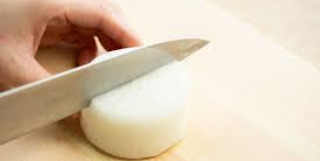Basic cutting techniques
基本的な食村の切り方
野菜の切り方
Vegetable cutting techniques
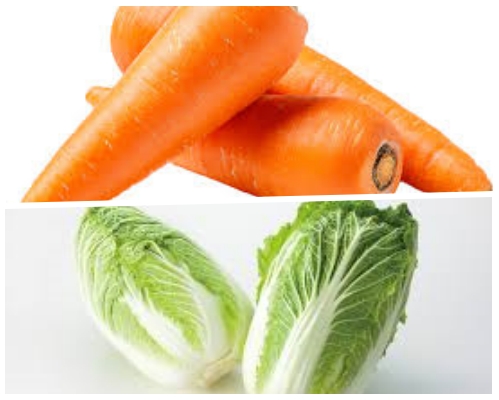
日本料理において、野菜の切り方は、実用性だけでなく、見た目や食感、味にも大切な役割を果たしています。日本の料理哲学では、素材に対して丁寧に敬意を持って扱うことが重視されており、それが切り方にも表れています。たとえば、千切りのような基本的な切り方は、サラダやスープに軽やかで繊細な食感を加え、乱切りは煮物などのしっかりとした味わいを引き出すのに役立ちます。季節の色や形を反映した見た目の美しさも大切で、切り方によって料理の美しさが際立ちます。
In Japanese cuisine, vegetable cutting techniques are essential not only for functionality but for their role in presentation, texture, and taste. These techniques showcase Japanese culinary philosophy, where ingredients are treated with respect and care. Each cut emphasizes precision and beauty, ensuring vegetables harmonize visually and texturally with other ingredients. For example, a basic cut like sengiri (thin julienne) adds a light, airy texture to salads or soups, while ran-giri (random cutting) helps bring out the flavor in heartier dishes like stews. Cutting techniques also enhance the ingredient’s presentation, often influenced by seasonal colors or shapes that add beauty to a dish.
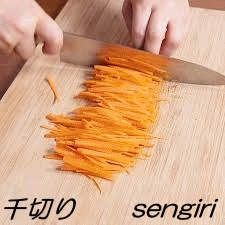
また、日本の包丁を正しく使うことも非常に重要です。柳刃包丁(刺身用)、薄刃包丁(野菜用)、出刃包丁(魚用)など、日本の包丁にはそれぞれ特定の用途があり、通常片刃で設計されています。この設計により、正確な動作や丁寧な取り扱いが求められます。たとえば、薄刃包丁の正しい使い方では、力をかけるのではなく、包丁の重みを利用して上下に軽く揺らすように動かし、繊細な野菜を傷つけることなく綺麗な切り口を作ります。日本料理の包丁技術と切り方を身につけることで、味、食感、見た目が調和し、一皿に美しさが加わるのです。
Using knives properly in the Japanese kitchen is equally crucial. Japanese knives, such as the yanagiba (for sashimi), usuba (for vegetables), and deba (for fish), are designed with specific tasks in mind and are typically single-beveled. This design requires careful handling and precise movements. For example, the proper usuba technique involves a rocking motion, using the weight of the knife rather than force, to create clean, consistent cuts without damaging delicate vegetables. Mastering knife skills and cuts in Japanese cuisine brings harmony to the final presentation, blending flavor, texture, and artistry into each dish.
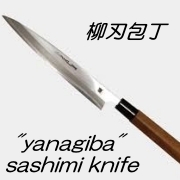
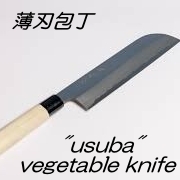
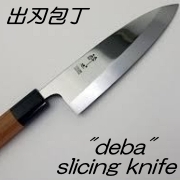
輪切り・Rounds
にんじんや大根、なすなどの材料を円形 に切ること。材料の皮を薄くむき、用途 によって厚さを揃え、均等に切っていく。
A technique used for slicing giant white radishes (daikon), carrots, and other cylindrical ingredients into rounds. Peel the ingredient thinly, and slice it crosswise for rounds of uniform thickness. The thickness depends on how the ingredient is to be used in dishes.
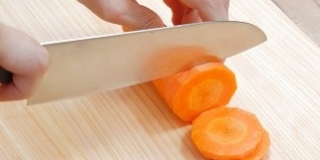
薄切り・Thin Slices
玉ねぎや大根を幅1mm程度の薄さに材料の 端から切っていく。スライサーを使えば より均等に仕上がる。
A technique used for slicing onions (tama-negi), giant white radishes (daikon) and other vegetables from one end into rounds of about 1mm thickness. Slicers are handy for realizing a more uniform finish.
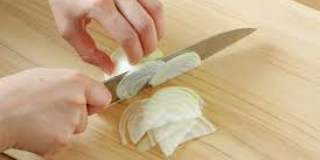
斜め切り・Diagonal Cut
長ねぎ、なす、きゅうりなどの厚さを 等に斜めに切っていく。 長ねぎ、なす、きゅうりなどの円筒形の野菜を斜めに切るときに使う技法。 厚みが均一になるように。
A technique used for cutting naga-negi onions, eggplants (nasu), cucumbers (kyuri) and other cylindrical vegetables diagonally. Make sure that the thickness is uniform.
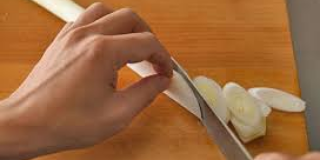
小口切り・Edge Cut
細長い野菜、ごぼう、長ねぎ、きゅうり などを輪切りの要領で切ること。 厚さを 揃え、均等に切っていく。
A technique used for slicing burdock (gobō), naga-negi onions, cucumbers (kyuri) and other long slender cylindrical vegetables into rounds. When slicing, make sure that the thickness is uniform.
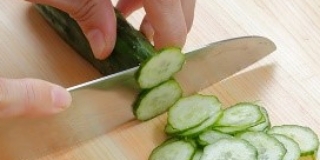
せん切り・Julienne Strips
キャベツ、レタス、青じそなどを繊維に そって、薄切りと同様に幅1mm程度に均等 に切っていく。
A technique used for cutting cabbages (kyabetsu), lettuces (retasu), green perilla (aojiso), etc. very thinly (about 1-mm thick). Vegetables should be cut in the same direction as their grain.
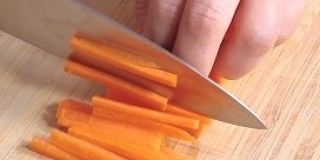
そぎ切り・Shaving Cut
主にしいたけや白菜に使われる切り方。 包丁を寝かせるように入れ、そぐように 切っていく。
A technique used for shiitake mushrooms and Chinese cabbages (hakusai). Shave vegetables thinly using the knife in such a way that it is almost laid on its side.

半月切り・Half-Moons
にんじんや大根、きゅうりなどの円筒状 の材料を縦半分に切り、輪切りの要領で 半月の形に切っていく。
A technique used for cutting carrots (ninjin), giant white radishes (daikon), cucumbers (kyuri) and other cylindrical vegetables into half-moons. Cut vegetables in half lengthwise, and then slice them crosswise.
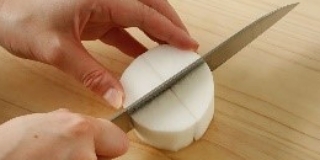
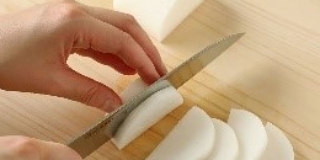
いちょう切り Quarter-Rounds
にんじんや大根などの円筒状の材料を縦 4等分に切り、厚さを均等にして、いち ょうの葉のように切っていく。
A technique used for cutting carrots (ninjin), giant white radishes (daikon) and other cylindrical vegetables into quarter-rounds. Cut vegetables in quarters lengthwise, and then slice them crosswise. Make sure that the thickness is uniform.

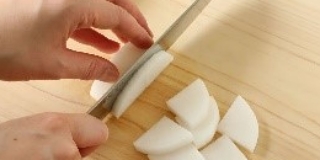
くし切り・Wedge Cut
トマト、オレンジ、レモンなど球形の材 料を縦に6~8等分に切り、くしのような 形にする。
A technique used for cutting tomatoes (tomato), oranges (orenji), lemons (remon) and other spherical foods into wedges. Cut foods lengthwise in sixths or eighths.
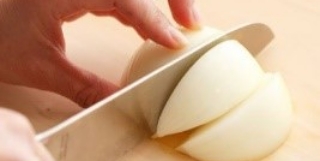
短冊切り・Rectangles
拍子切りの要領で材料を長さ4~5cmに切 り、それを繊維にそって薄切りに切って いき、それをそのまま横にたおして幅8mm 程度に切っていく。
Cut vegetables into 4 to 5-cm lengths. Cut them thinly in the same direction as their grain. Lay them on their side, and cut them into rectangles of about 8-mm thickness.
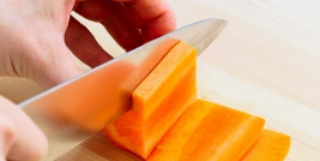
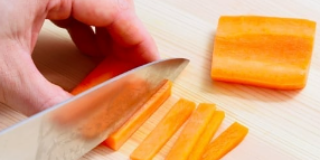
細切り・Thin Cut
材料を長さ4~5cmに切ってから、繊維に そって縦に2mm程度に切っていき、そのま ま横にたおして2mm程度に切っていく。
Cut vegetables into 4 to 5-cm lengths. Cut them lengthwise in the same direction as their grain into rectangles of about 2-mm thickness. Lay them on their side, and cut them into thin pieces of about 2-mm thickness.
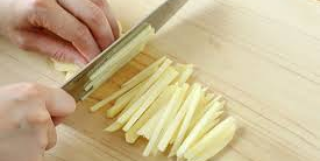
拍子切り・Bar Rectangles
材料を長さ3~4cmに揃えて切る。繊維にそ って厚さ5〜6mmに切っていく。次に切った ものを横にたおし、幅5~6mm程度に切り、 拍子のような形に揃えながら切っていく。
Cut vegetables into 3 to 4-cm lengths. Cut them in the same direction as their grain into rectangles of 5 to 6-mm thickness. Lay them on their side, and cut them into bars of 5 to 6-mm thickness.
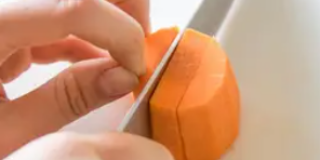

さいの目切り・Cube Cut
拍子切りにした材料を端から幅1cm程度 に切り、さいころ状にする。
Cut bar rectangles from one end into cubes of about 1-cm thickness.
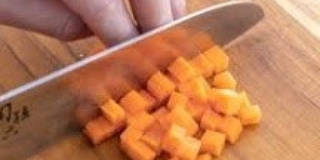
乱切り・Rolling Wedges
包丁を斜めに入れて、野菜を回し、角度 を変えながら大きさをほぼ一定にして切 っていく。
Make diagonal cuts while rotating vegetables a quarter turn between cuts.
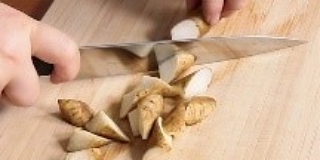
針しょうが・Ginger Needles
皮をむいたしょうがを薄切りにし、それ を4〜5枚重ね繊維にそって針のように細 く切っていく。
Slice peeled ginger (shoga) thinly. Then, cut a stack of 4 to 5 slices in the same direction as their grain into thin needle-like shapes.
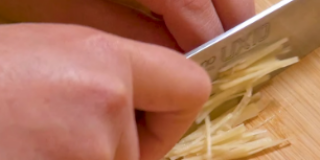
あられ切り・Dice Cut
さいの目切りより小さな切り方。材料を長 さ4~5cmに揃えて5mm程度の厚さに切り、 拍子切りの要領で切っていく。それを端か ら5mmに大きさを揃えて切っていく。
A technique used for cutting vegetables into cubes with a size smaller than those of the cube cut technique. Cut vegetables into 4 to 5-cm lengths. Then, cut them lengthwise into rectangles of about 5-mm thickness as in the bar rectangles technique. Cut them from one end into 5-mm cubes.
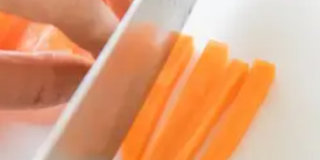
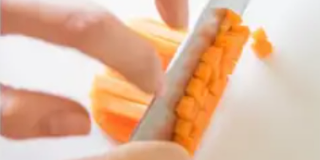
ささがき・Sasagaki Shavings
ごぼうの皮をたわしや包丁の背でこそげ 落としてから端から5cmくらいのところま で十字に切り込みを入れ、鉛筆を削る要 領で端からごぼうを少しずつ回しながら そぎ落としていく。
Scrape off the burdock (gobō) skin with a tawashi kitchen brush or using the back of a knife. Make a lengthwise cross-shape incision about 5-cm deep at one end, and cut it from that end as if you were sharpening a pencil while rotating little by little with the other hand.
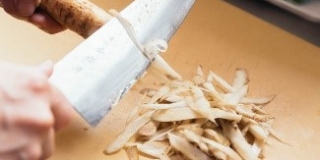
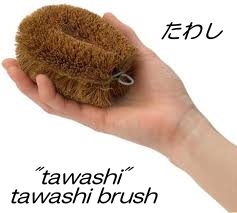
みじん切り(玉ねぎ)・Fine Chopping (Onions)
縦半分に切り、そのまま横にたおし幅5mm 程度に薄切りに切っていく。次に横から 包丁を入れる。端から細かく切っていく。
Cut onions (tama-negi) in half lengthwise. Then, with the cut face down, slice them into pieces of about 5-mm thickness. Make sideway Cuts. Cut them finely from one end.
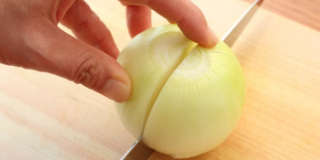
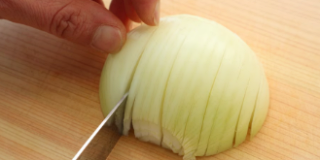
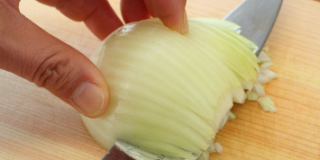
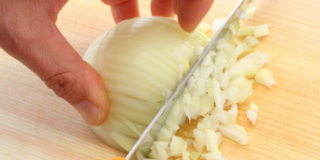
白髪ねぎ・Naga-Negi Onion “Gray Hair” Cut
長ねぎの白い部分を4~5cm程度の長さに 切り、縦に1本の切り込みを入れてから中 心(青い部分のみ)を取り除き材料を重ね て、せん切りの要領で細く切っていく。
Cut the white portion of naga-negi onions into 4 to 5-cm lengths. Make an incision in their center to remove the soft green core. Cut them thinly as in the julienne strips technique.
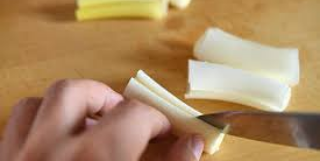
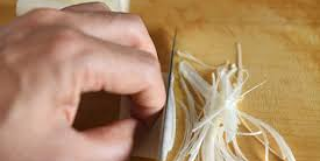
末広切り・Fan Cut
4~5cmの長さに切り、一片の端を1/4程 残して縦に細く切り目を入れ、切り目を 寝かせるように左右に広げる。
Cut vegetables into 4 to 5-cm lengths. Make lengthwise cuts at narrow, even intervals through all but about one-fourth of the entire length at one end. Gently spread open the “fan”.
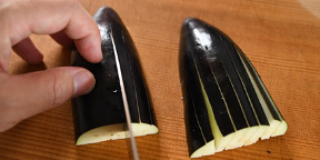
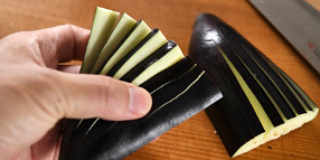
しいたけの飾り切り・Shiitake Decorative Cut
生しいたけに3本の切り込みを入れ、切り 込みに向かって包丁を左右から斜めに削 るように切り込みを入れていく。
Make three incisions on top of each shiitake mushroom, and bevel these cuts by inserting the knife diagonally into them.
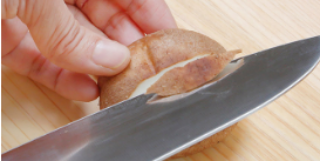
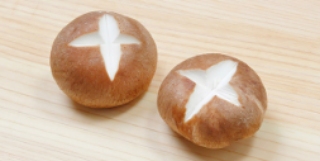
切り違いきゅり・ Cucumber Peaks
4〜5cm程の筒切りにしたきゅうりの真ん 中に切り目を入れ、切り目に届くように 45度斜めに切り込みを入れる。裏返して 同じように切り目を入れる。
Cut cucumber into 4 to 5-cm lengths. Run the knife through the center of a length, and make a diagonal cut(45°) halfway through the cucumber up to the center cut. Make an identical diagonal cut from the other side.
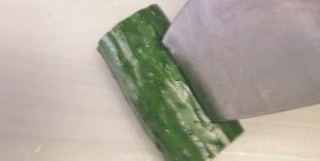
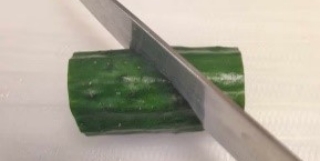
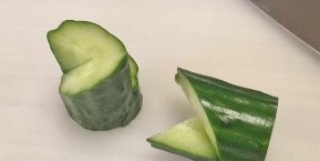
面取り Bevel-Edged Cylinders
主に大根やいも類で使うことが多い切り 方。材料の角の部分を包丁の角度を一定 にし、左手で大根を回転させながら包丁 を送り込み、面を取っていく。
A technique often used for giant white radishes (daikon) and potatoes (imo). Edges of ingredients are beveled for a neat appearance. Apply the knife to the edge of an ingredient at a certain angle, and rotate the ingredient with the left hand.
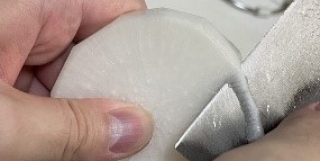
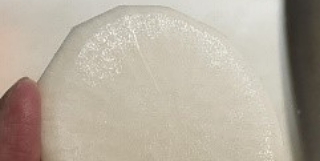
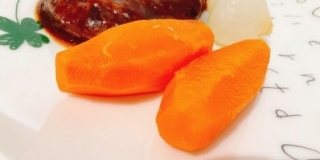
隠し包丁・Penetration- Facilitating Cut
面取りしたものを煮る時に味がしみ込み やすく、火の通りを早くするため、裏面 に全体の厚みの1/3くらいまでの十字の 切り込みを入れる。
Make a cross-shape incision from one end of a bevel-edged cylindrical ingredient up to about ⅓ of the length. This will facilitate the penetration of seasonings and heat when simmering them.
